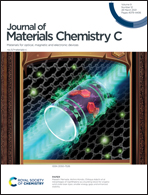Deep-blue fluorophores with imidazoacridine acceptors: enhancing photostability and two-photon fluorescence using structural constraint†
Abstract
Efficient deep blue luminescent materials are highly sought after for applications in both electronics and bioimaging. Development of such materials has been progressing rapidly, yet fluorophores with high photostability emitting in this region remain uncommon. Herein we report the synthesis of three donor–acceptor dyes based on benzimidazole acceptors and triphenylamine donors. These materials have deep blue emission, CIE(x, y) < (0.17, 0.09), quantum yields above 95% and narrow emission spectra. We demonstrate that restriction of rotational freedom in these compounds, particularly in the triarylamine donor, reduces the rate of photobleaching by up to a factor of 4. Locking these chromophores into planar configurations also improves their cross-section for two-photon excited fluorescence. Proof-of concept studies incorporating these dyes into water-soluble polymer dots suitable for bio-imaging was also demonstrated.



 Please wait while we load your content...
Please wait while we load your content...